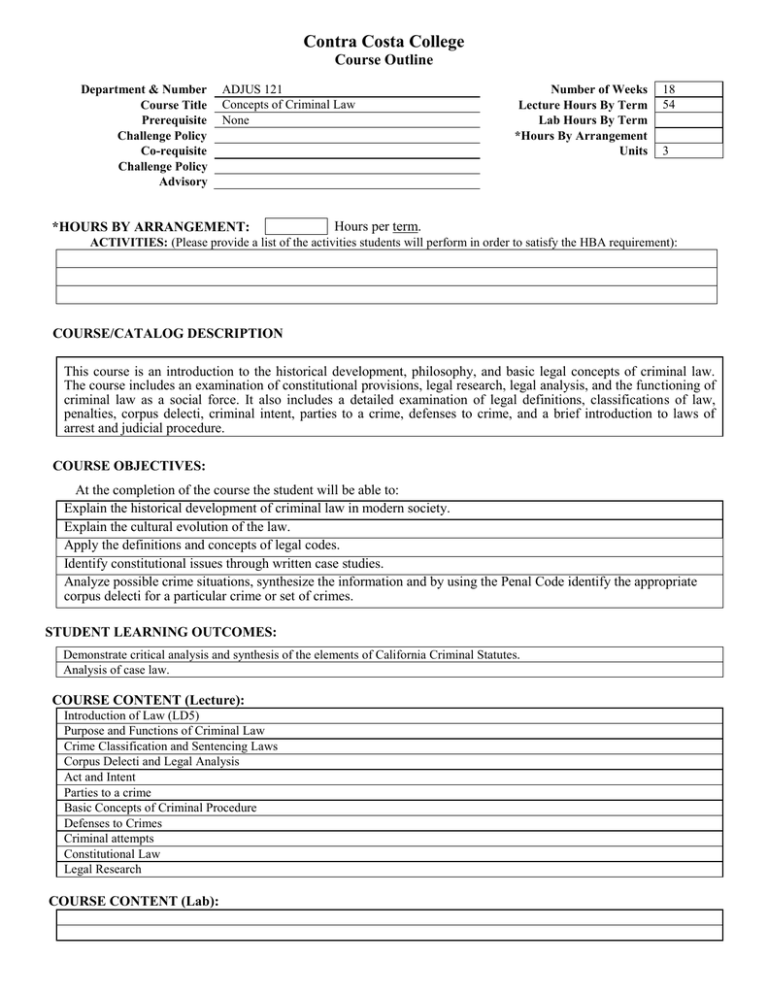ADJUS 121-FA13.doc 78KB Apr 02 2014 01:46:36 PM
advertisement

Contra Costa College Course Outline Department & Number Course Title Prerequisite Challenge Policy Co-requisite Challenge Policy Advisory ADJUS 121 Concepts of Criminal Law None *HOURS BY ARRANGEMENT: Number of Weeks Lecture Hours By Term Lab Hours By Term *Hours By Arrangement Units 18 54 3 Hours per term. ACTIVITIES: (Please provide a list of the activities students will perform in order to satisfy the HBA requirement): COURSE/CATALOG DESCRIPTION This course is an introduction to the historical development, philosophy, and basic legal concepts of criminal law. The course includes an examination of constitutional provisions, legal research, legal analysis, and the functioning of criminal law as a social force. It also includes a detailed examination of legal definitions, classifications of law, penalties, corpus delecti, criminal intent, parties to a crime, defenses to crime, and a brief introduction to laws of arrest and judicial procedure. COURSE OBJECTIVES: At the completion of the course the student will be able to: Explain the historical development of criminal law in modern society. Explain the cultural evolution of the law. Apply the definitions and concepts of legal codes. Identify constitutional issues through written case studies. Analyze possible crime situations, synthesize the information and by using the Penal Code identify the appropriate corpus delecti for a particular crime or set of crimes. STUDENT LEARNING OUTCOMES: Demonstrate critical analysis and synthesis of the elements of California Criminal Statutes. Analysis of case law. COURSE CONTENT (Lecture): Introduction of Law (LD5) Purpose and Functions of Criminal Law Crime Classification and Sentencing Laws Corpus Delecti and Legal Analysis Act and Intent Parties to a crime Basic Concepts of Criminal Procedure Defenses to Crimes Criminal attempts Constitutional Law Legal Research COURSE CONTENT (Lab): METHODS OF INSTRUCTION: Live or computer enhanced lecture Demonstrations, discussion Group work Audio-visual instruction Guest Speakers INSTRUCTIONAL MATERIALS: NOTE: To be UC/CSU transferable, the text must be dated within the last 7 years OR a statement of justification for a text beyond the last 7 years must be included. Textbook Title: Author: Publisher: Edition/Date: Textbook Reading Level: Justification Statement: California Criminal Law Concepts Hunt and Rutledge Pearson 13th /2013 13 OUTSIDE OF CLASS WEEKLY ASSIGNMENTS: Title 5, section 55002.5 establishes that a range of 48 -54hours of lecture, study, or lab work is required for one unit of credit. For each hour of lecture, students should be required to spend an additional two hours of study outside of class to earn one unit of credit. State mandates that sample assignments must be included on the Course Outline of Record. Outside of Class Weekly Assignments Hours per week Weekly Reading Assignments (Include detailed assignment below, if applicable) 2 Students are required to read one chapter per week and take notes for each chapter. Weekly Writing Assignments (Include detailed assignment below, if applicable) 2 Students must read and brief 8 legal case briefs per semester. In addition they are required to review instructor feedback and resubmit each assignment based on instructor feedback. Weekly Math Problems (Include detailed assignment below, if applicable) Lab or Software Application Assignments (Include detailed assignment below, if applicable) Other Performance Assignments (Include detailed assignment below, if applicable) 2 Students are required to participate in online discussion and conduct research when necessary to post comments. In addition they are required to complete one homework quiz per chapter including a one remediation. Student are also required to use the homework quizzes to prepare for the midterm and final. 20 STUDENT EVALUATION: (Show percentage breakdown for evaluation instruments) 25 25 50 % % % % Online Discussions/ participation Case Briefs Testing GRADING POLICY: (Choose LG, P/NP, or SC) Pass / No Pass x Letter Grade 90% - 100% = A 80% - 89% = B 70% and above = Pass Below 70% = No Pass Student Choice 90% - 100% = A 80% - 89% = B 70% - 79% = C 60% - 69% = D Below 60% = F Prepared by: R. Ramos Date: 11/4/13 Revised form 10/13 70% - 79% = C 60% - 69% = D Below 60% = F or 70% and above = Pass Below 70% = No Pass


